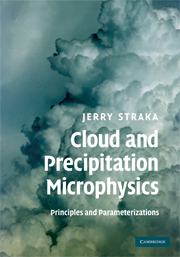Book contents
- Frontmatter
- Contents
- Preface
- 1 Introduction
- 2 Foundations of microphysical parameterizations
- 3 Cloud-droplet and cloud-ice crystal nucleation
- 4 Saturation adjustment
- 5 Vapor diffusion growth of liquid-water drops
- 6 Vapor diffusion growth of ice-water crystals and particles
- 7 Collection growth
- 8 Drop breakup
- 9 Autoconversions and conversions
- 10 Hail growth
- 11 Melting of ice
- 12 Microphysical parameterization problems and solutions
- 13 Model dynamics and finite differences
- Appendix
- References
- Index
12 - Microphysical parameterization problems and solutions
Published online by Cambridge University Press: 23 November 2009
- Frontmatter
- Contents
- Preface
- 1 Introduction
- 2 Foundations of microphysical parameterizations
- 3 Cloud-droplet and cloud-ice crystal nucleation
- 4 Saturation adjustment
- 5 Vapor diffusion growth of liquid-water drops
- 6 Vapor diffusion growth of ice-water crystals and particles
- 7 Collection growth
- 8 Drop breakup
- 9 Autoconversions and conversions
- 10 Hail growth
- 11 Melting of ice
- 12 Microphysical parameterization problems and solutions
- 13 Model dynamics and finite differences
- Appendix
- References
- Index
Summary
Autoconversion of cloud to drizzle or rain development
Over the past four decades, autoconversion schemes have changed very little. Starting back in the late 1960s two forms emerged, from Berry (1968b) and Kessler (1969). The Berry scheme converted cloud water to rain water, but it did this far too quickly. In fact as soon as cloud was formed the initial Berry (1968b) scheme produced raindrops, which then grew by accretion of cloud drops. Kessler (1969) had a scheme that was designed primarily for warm-rain processes, and was different from the Berry (1968b) scheme in design. The Kessler scheme required that cloud-content amounts reached a certain value before rain was produced. The Kessler was and is still used to an amazingly large extent in cloud models.
Later, some started using a modified form of the Berry 1968 scheme again, but this time with a 2 kg kg−1 cut-off value for the cloud-water mixing ratio after which rain would form. However, it had no equation for number concentration and was used in models that only permitted prediction of the third moment, i.e. the mixing ratio (e.g. Lin et al. 1983; Ferrier 1994; Gilmore et al. 2004a; and Straka and Mansell 2005). After correcting for errors the Berry and Reinhardt (1974b) method became popular in some groups to predict mixing ratio and number-concentration conversion. Cohard and Pinty (2000) showed that, when programmed correctly, this scheme produced reasonable results against quasi-stochastic-growth-equation results.
Information
- Type
- Chapter
- Information
- Cloud and Precipitation MicrophysicsPrinciples and Parameterizations, pp. 336 - 345Publisher: Cambridge University PressPrint publication year: 2009
